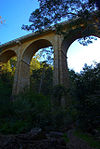
Lithgow is a town in the Central Tablelands of New South Wales, Australia and is the administrative centre of the City of Lithgow local government area. It is located in a mountain valley named Lithgow's Valley by John Oxley in honour of William Lithgow, the first Auditor-General of New South Wales.

Rockdale railway station is a heritage-listed railway station located on the Illawarra line, serving the Sydney suburb of Rockdale in Bayside Council. It is served by Sydney Trains T4 line services. It was added to the New South Wales State Heritage Register on 2 April 1999.
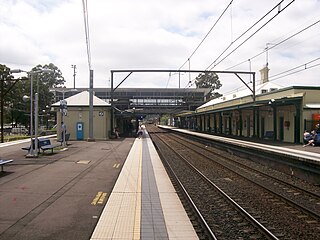
Penrith railway station is a heritage-listed railway station located on the Main Western line in the western Sydney suburb of Penrith in the City of Penrith local government area of New South Wales, Australia. It was designed by New South Wales Government Railways and the 1863 building was built by M. and A. Jamison and D. Forest. It is also known as Penrith Railway Station group. The property was added to the New South Wales State Heritage Register on 2 April 1999.

Hamilton railway station is a heritage-listed railway station on the Newcastle line in the inner Newcastle suburb of Hamilton in New South Wales, Australia. It was added to the New South Wales State Heritage Register on 2 April 1999.

Valley Heights railway station is a heritage-listed railway station located on the Main Western line in Valley Heights, in the City of Blue Mountains local government area of New South Wales, Australia. It was designed and built by NSW Government Railways. It is also known as Valley Heights Railway Station and Locomotive Depot and The Valley. The property was added to the New South Wales State Heritage Register on 2 April 1999.

Lawson railway station is a heritage-listed railway station located on the Main Western line in Lawson in the City of Blue Mountains local government area of New South Wales, Australia. It is also known as Lawson Railway Station Group and Christmas Swamp; Blue Mountain. The property was added to the New South Wales State Heritage Register on 2 April 1999. The station opened on 11 July 1867 as Blue Mountain, being renamed Lawson on 21 April 1879. A passing loop exists north of Platform 1. As part of widening work to the Great Western Highway, a siding south of Platform 2 was removed and a new submerged siding constructed west of the station.

Katoomba railway station is a heritage-listed railway station located on the Main Western line in Katoomba, New South Wales, Australia. It serves the Blue Mountains town of Katoomba opening on 2 February 1874 as Crushers, being renamed Katoomba on 9 July 1877.
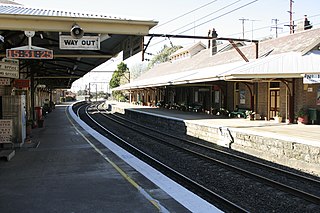
Mount Victoria railway station is a heritage-listed former barracks and now staff accommodation, guest accommodation, railway signal box and railway station located on the Main Western line in Mount Victoria in the City of Blue Mountains local government area of New South Wales, Australia. It was designed by NSW Government Railways and built from 1868 to 1913 by Allan McClean and James Barrie (1868 building). It is also known as Mount Victoria Railway Station group. The property was added to the New South Wales State Heritage Register on 2 April 1999. The station opened on 1 May 1868.

Lithgow railway station is a heritage-listed former station master's residence and railway station located on the Main Western line at Railway Parade, Lithgow, City of Lithgow, New South Wales, Australia. It was designed and built by New South Wales Government Railways and built from 1924 to 1925. It is also known as Lithgow Railway Station Group and Residence and Eskbank East. The property was added to the New South Wales State Heritage Register on 30 August 2013. The station has frequent NSW TrainLink services running to and from Sydney Central.

Muswellbrook railway station is a heritage-listed railway station located on the Main Northern line in Muswellbrook, in the Muswellbrook Shire local government area of New South Wales, Australia. The station serves the town of Muswellbrook and was designed by John Whitton, the Chief Engineer of NSW Railways. It is also known as Muswellbrook Railway Station and yard group and Musclebrook Railway Station. The property was added to the New South Wales State Heritage Register on 2 April 1999.
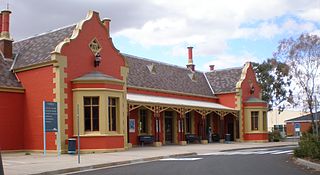
Bathurst railway station is a heritage-listed railway station at Havannah Street, Bathurst, Bathurst Region, New South Wales, Australia. It is situated on the Main Western line and serves the city of Bathurst. It was added to the New South Wales State Heritage Register on 2 April 1999.

The City of Lithgow is a local government area in the Central West region of New South Wales, Australia. The area is located adjacent to the Great Western Highway and the Main Western railway line.

Junee railway station is a heritage-listed railway station located on the Main Southern line in New South Wales, Australia. It serves the town of Junee in the Junee Shire. It was added to the New South Wales State Heritage Register on 2 April 1999.

Parkes railway station is a heritage-listed former locomotive depot and railway station and now locomotive roundhouse and railway station located on the Broken Hill line in May Street, Parkes in the Parkes Shire local government area of New South Wales, Australia. The railway station serves the town of Parkes and was built from 1881 to 1893. It is also known as the Parkes Railway Station group. The property was added to the New South Wales State Heritage Register on 2 April 1999.

Casino railway station is a heritage-listed railway station on the North Coast line in New South Wales, Australia. Opening on 22 September 1930, it serves the town of Casino in the Richmond Valley Shire. It was added to the New South Wales State Heritage Register on 2 April 1999.

Broadmeadow Locomotive Depot was a large locomotive depot consisting of two roundhouse buildings and associated facilities constructed by the New South Wales Government Railways adjacent to the marshalling yard on the Main Northern line at Broadmeadow. Construction of the locomotive depot at Broadmeadow commenced in 1923 to replace the existing crowded loco sheds at Woodville Junction at Hamilton, with the depot opening in March 1924. It was added to the New South Wales State Heritage Register on 2 April 1999.
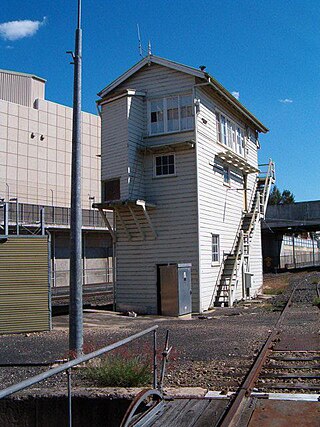
Railway Signal Cabin and Turntable is a heritage-listed signal box at Ellenborough Street near the Ipswich railway station, Ipswich, City of Ipswich, Queensland, Australia. It was built from 1881 to 1895. It was added to the Queensland Heritage Register on 27 May 2005.

The Lithgow Blast Furnace is a heritage-listed former blast furnace and now park and visitor attraction at Inch Street, Lithgow, City of Lithgow, New South Wales, Australia. It was built from 1906 to 1907 by William Sandford Limited. It is also known as Eskbank Ironworks Blast Furnace site; Industrial Archaeological Site. The property is owned by Lithgow City Council. It was added to the New South Wales State Heritage Register on 2 April 1999.
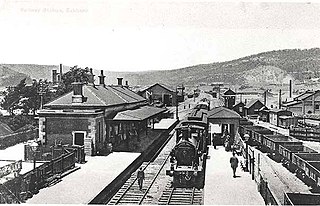
The Eskbank railway station is a heritage-listed former locomotive depot and railway station and now community group venue adjacent to the Main Western Line at Lithgow, City of Lithgow, New South Wales, Australia. It was designed by the New South Wales Government Railways and the station building was built by Goodsell & Wright, as a contractor. It is also known as Eskbank Railway Station group and Lithgow Goods Station/ Lithgow Site S1. The property was added to the New South Wales State Heritage Register on 2 April 1999.

Eskbank House is a heritage-listed former mine owner's residence, iron and steel works manager's residence, school and boarding house and now museum, event venue and community resource centre at 70 Inch Street, Lithgow, City of Lithgow, New South Wales, Australia. It was designed by an unknown architect and built from 1841 to 1842 by Alexander Binning, a stonemason, using convict labour. It is also known as Eskbank House and Moveable Collections and Esk Bank House; The Grange. The property is owned by Lithgow City Council. The residence was added to the New South Wales State Heritage Register on 24 August 2018.






















